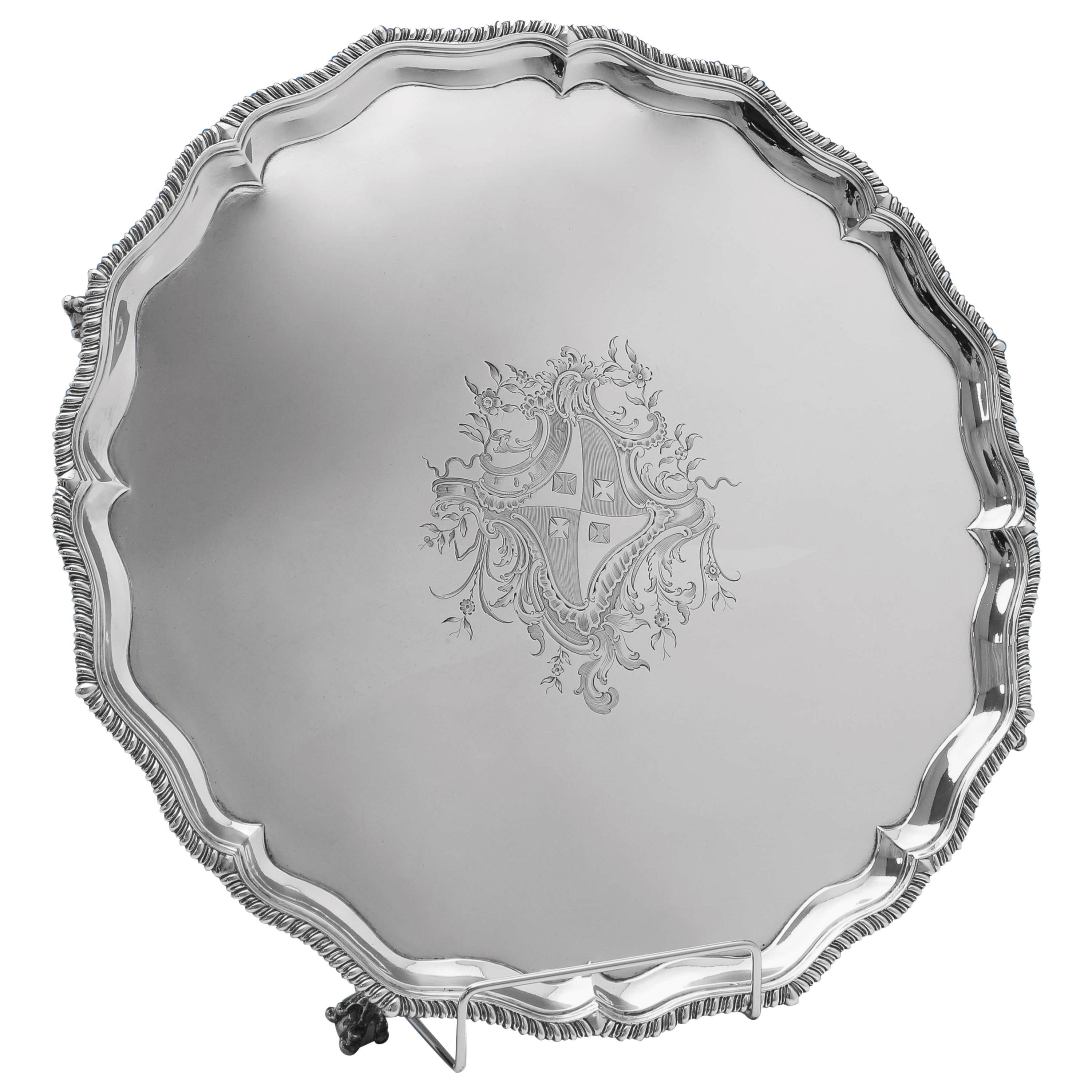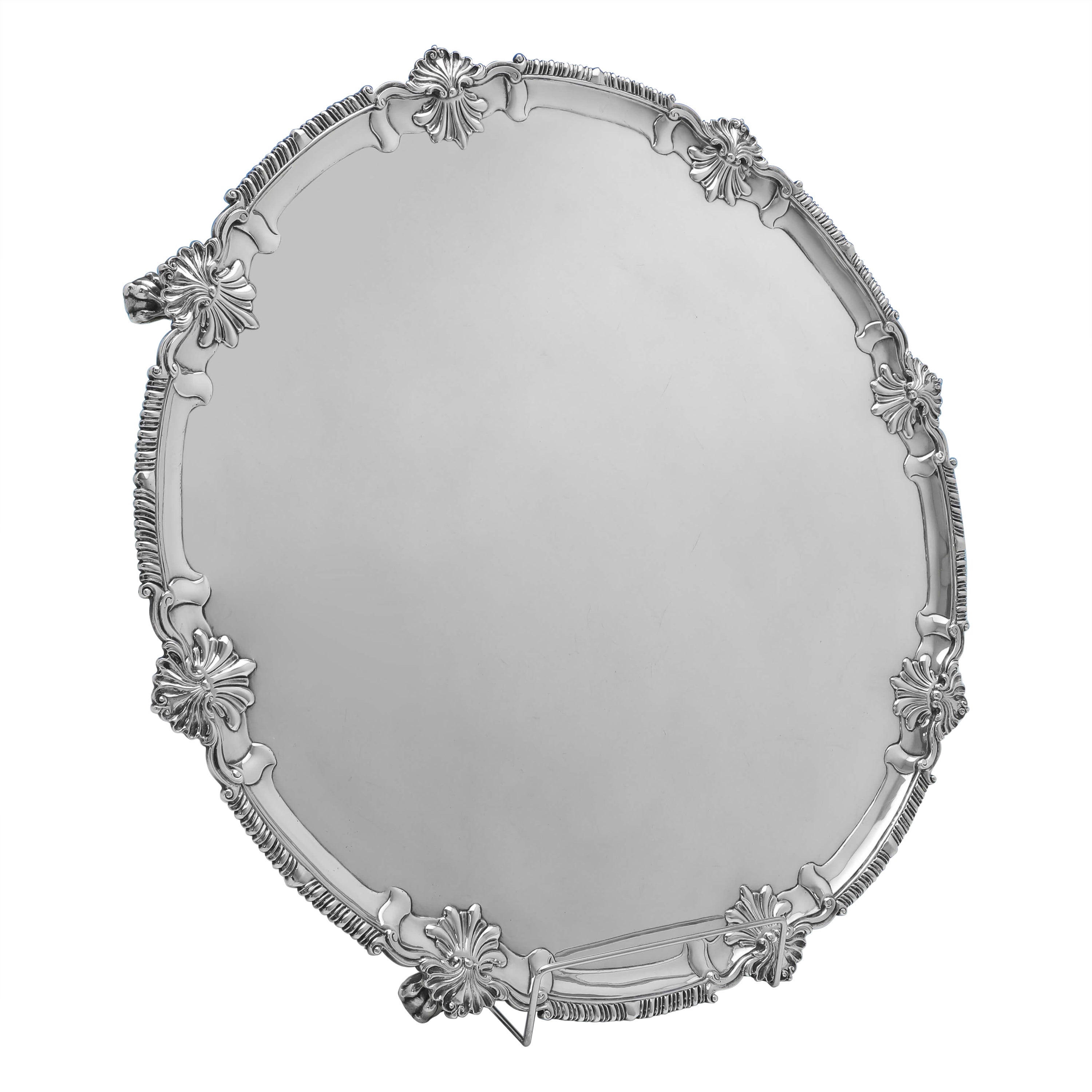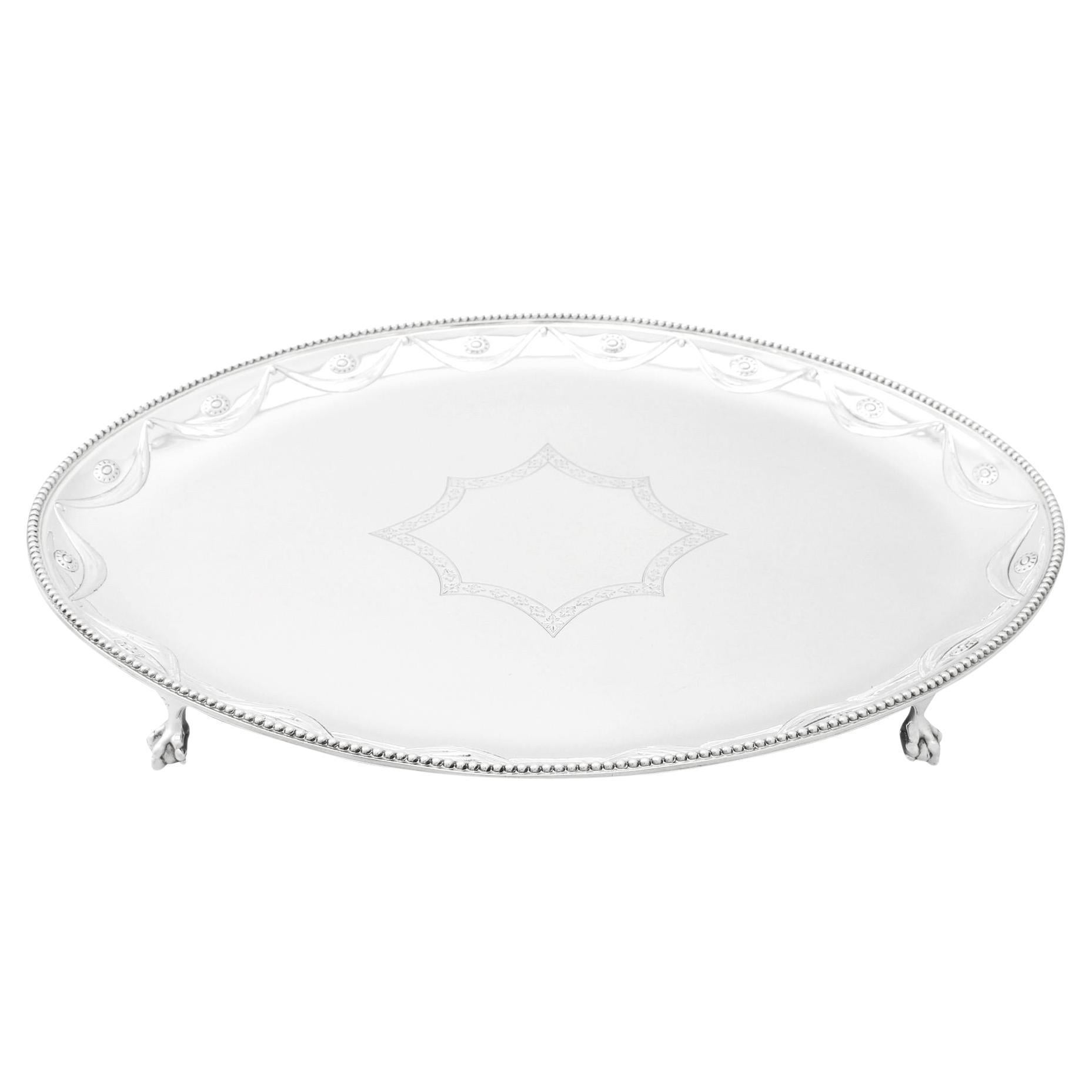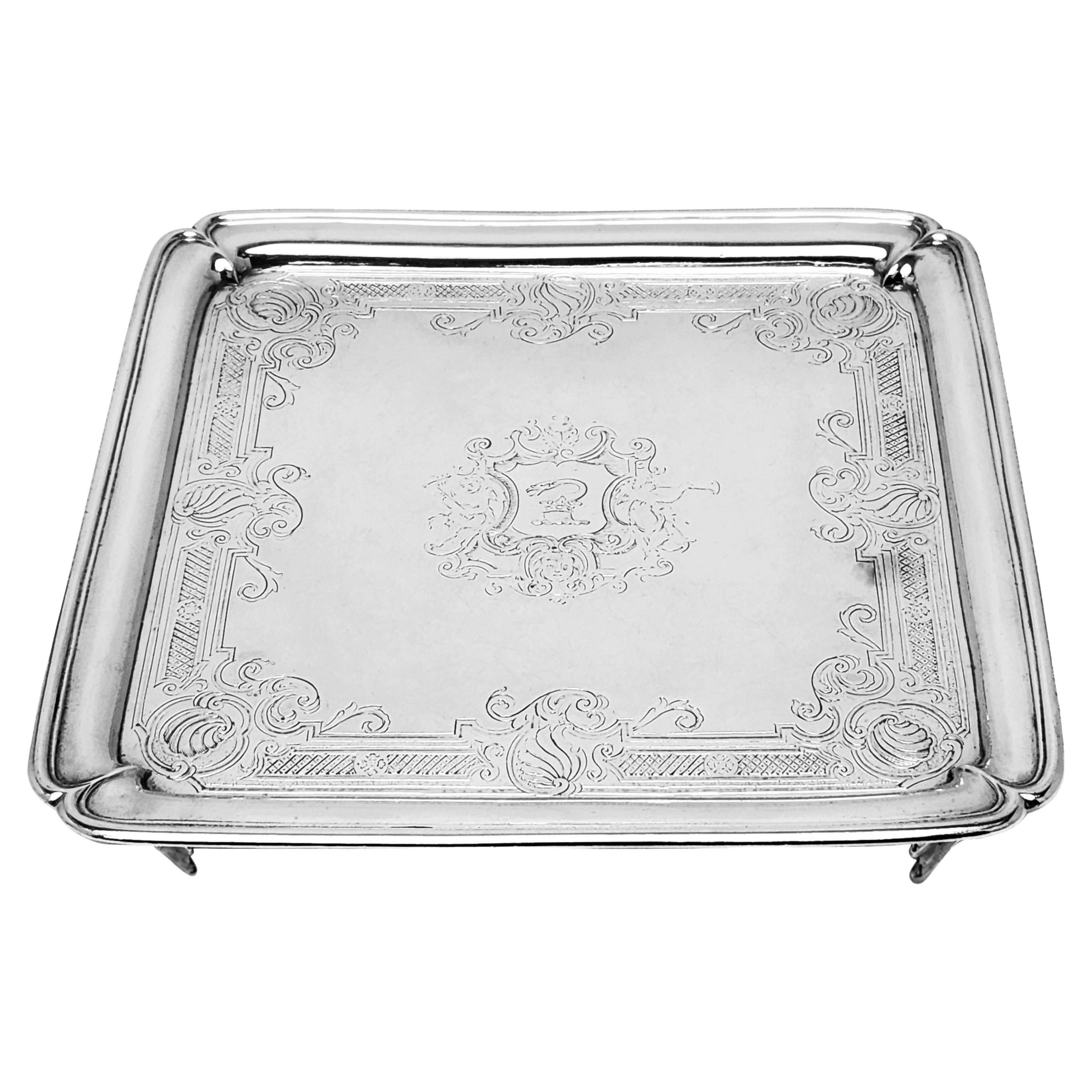Items Similar to Antique Pair Sterling Silver Salvers by John Carter 1772 18th C
Want more images or videos?
Request additional images or videos from the seller
1 of 21
Antique Pair Sterling Silver Salvers by John Carter 1772 18th C
About the Item
This is a wonderful pair of English 18th Century antique sterling silver salvers by the renowned silversmith John Carter.
They each have hallmarks for London 1772, the makers mark of John Carter and are typical of his work with the exquisitely detailed rims, ball and claw feet and the superb engraved decoration.
They each bear a beautifully engraved coat of arms and the crest of the Terry Family, which I have researched:
The Arms of the Family of Terry
The arms as engraved upon this Pair of George III English Sterling Silver Footed Salvers by John Carter hallmarked London 1872 are those of the family of Terry. They may be blazoned as follows:
Arms: Sable on two bars or three cross crosslets two and one (……?) and issuant from the bar in chief a demi-lion rampant
Crest: A boar’s head erased and erect
Motto: E cruce leo [From the cross a lion]
The arms as engraved upon this pair of salvers certainly have characteristics with arms borne by another family and branch thereof named Terry who hailed from the County of Cork in Ireland. Notably the use of the three cross crosslets and the demilion rampant, but in a different placement upon the arms. The crest seen here is also at a variance with the other Terry arms where a demi-lion rampant is used. Upon an exhaustive examination of other sources, together with the present evidence, I believe that the family who had the salvers in their possession undoubtedly bore these arms without authority a fact that often occurred in the 18th and 19th Centuries and at other periods. Many families bore armorial bearings that they assumed and used for many generations in that they either consciously or unconsciously eschewed an approach to The College of Arms in England, the Ulster King of Arms in Ireland, or the Court of the Lord Lyon in Scotland to legitimatise such arms.
This superb pair of salvers will look superb in your silver collection.
Condition:
In really excellent condition with clear hallmarks and no dings, dents or signs of repair. Please see photos for confirmation.
Dimensions in cm:
Height 4 x Width 34 x Depth 34
Weight 2.58 kg
Dimensions in inches:
Height 2 inches x Width 1 foot, 1 inch x Depth 1 foot, 1 inch
Weight 83 troy oz
John Carter
John Carter was a London silversmith who specialised almost exclusively in candlesticks and salvers. He entered his first mark in 1776, but earlier also supplied his products to the celebrated workshop of John Parker and Edward Wakelin.
- Creator:John Carter (Maker)
- Dimensions:Height: 1.58 in (4 cm)Width: 13.39 in (34 cm)Depth: 13.39 in (34 cm)
- Sold As:Set of 2
- Materials and Techniques:
- Place of Origin:
- Period:1770-1779
- Date of Manufacture:1772
- Condition:
- Seller Location:London, GB
- Reference Number:
About the Seller
5.0
Platinum Seller
These expertly vetted sellers are 1stDibs' most experienced sellers and are rated highest by our customers.
Established in 1983
1stDibs seller since 2012
1,196 sales on 1stDibs
Typical response time: 1 hour
Associations
LAPADA - The Association of Arts & Antiques Dealers
- ShippingRetrieving quote...Ships From: London, United Kingdom
- Return PolicyA return for this item may be initiated within 14 days of delivery.
More From This SellerView All
- Antique George III Sterling Silver Salver by Paul Storr 1811 19th CenturyBy Paul StorrLocated in London, GBThis is a wonderful English antique George III sterling silver 10 inch salver, by the world famous silversmith Paul Storr. It has clear hallmarks for London 1811 and the makers mark of Paul Storr. It is typical of his work with the raised gadrooned rim with anthemion at intervals, on four fabulous foliate bracket feet. The salver is engraved with a crest and motto and the underside is later engraved Charlotte J. Parke from C. J. Parke, March 1893' The centre is engraved with a crest above a motto 'True and Fast' and I have researched this crest: The Crest of Parke The crest as engraved upon this George III English Sterling Silver Footed Salver by Paul Storr hallmarked London 1811 is that of the family of Parke. It may be blazoned as follows: Crest: A stag’s head couped sable holding in the mouth a key or Motto: True and fast The family of Parke originally hailed from the County of Cumberland in the northeast of England1 later settling in the County of Dorset at Henbury House, Sturminster Marshal, near Wimborne. Given the evidence of the inscription found on the underside of the salver ‘Charlotte J. Parke from C. J. Parke, March 1893’ it was undoubtedly at one time in the possession of Charles Joseph Parke (died 9th March 1893) of Henbury House aforesaid and gifted to Charlotte Josephine Parke (baptised 4th January 1857 died 2nd January 1941) his third daughter by his wife, Ellen Mary Ethelston. I would venture the following hypothesis that the salver was bequeathed to Charlotte in her father’s will that was granted probate at London on the 20th May 1893. The ‘March 1893’ of the inscription acts as a remembrance of the month of the death of her father. It was noted that Charlotte’s father left an estate worth some £66,892, 19 shillings and one pence, a very considerable sum in the last decade of the 19th Century and even thereafter. Charlotte never married and was living at the time of her death at The Coppice, Sixpenny Handley in the County of Dorset. Her will was proved for probate at Llandudno on the 25th March 1941. She left an estate worth £18,866, 10 shillings and 4 pence. Again, a comfortable sum in 1941. See the photo of Henbury House, Sturminster Marshal, near Wimborne, Co. Dorset. The former seat of the Parke family. The house was destroyed by fire, the remains of which were demolished in the 1990's. There is no mistaking its unique quality and design, which is sure to make it a treasured piece by any discerning collector. Condition: In excellent condition with clear hallmarks and no dings, dents or signs of repair. Please see photos for confirmation. Dimensions in cm: Height 2 x Width 26.5 x Depth 26.5 Weight 0.69 kg Dimensions in inches: Height 1 inch x Width 10 inches x Depth 10 inches Weight 1.5 lbs Paul Storr born in London England in 1771, was to become one of the most talented silversmiths of the nineteenth century. Today his legacy of exceptionally well crafted silver, found worldwide in museums and private collections, leaves one in awe when compared to that of his contemporaries.After having served a seven year apprenticeship from the age of 14, he began his career in 1792 when he went into a brief partnership with William Frisbee. This did not last and in 1793 a new mark, (his initials ‘P S’) was entered. By the beginning of the nineteenth century he had established himself as one of London’s top silversmiths producing, amongst others, commissions for Royalty. In 1801 he married Elizabeth Susanna Beyer with whom he was to have ten children. In 1807 Paul Storr entered into a working relationship with Philip Rundell and by 1811 was a partner, and managing the workshops for Rundell, Bridge & Rundell. During this period he kept his own marks and separate workshop. However it was through Rundell, Bridge & Rundell who were appointed Goldsmith in Ordinary to George III in 1804 that his reputation as a master silversmith grew. His talents lay in being able to transform ideas and designs from Rundell, Bridge & Rundell’s designers, William Theed...Category
Antique 1810s English George III Sterling Silver
MaterialsSterling Silver
- Antique Large William IV Silver Tray Salver by Paul Storr 1837 19th CenturyBy Paul StorrLocated in London, GBThis is a wonderful English antique William IV sterling silver tray, or salver, by the world famous silversmith Paul Storr. It has clear hallmarks for London 1837 the makers mark of Paul Storr and is also engraved Storr & Mortimer 36, they were Goldsmiths and Jewellers to Her Majesty’ (1822-1839). It is typical of his work with the octafoil shape and the exquisitely detailed foliate and acorn rim. It is raised on four delightful foliate and scroll feet. The centre is engraved with a shield shaped coat of arms encompassing the lion rampant which I have had researched: The Arms of the Family of King The arms as engraved upon this William IV English Sterling Silver Footed Salver by Paul Storr hallmarked London 1837 are those of the family of King. They may be blazoned as follows: Arms: Sable a lion rampant between three crosses formy fitchy argent Undoubtedly this salver was in the possession of a gentleman who was member of a family bearing the name of King. There are a number of variants of these armorial bearings being borne by King families. Very often the lion is of a different tincture but the field of the shield is invariably remains ‘sable’. Similar arms and crest were recorded by Sir Edward Bysshe, Clarenceux King of Arms in his Visitation of the County of Kent of 1663 to the family of King, of Bromley. The tinctures of both arms and crest of King, of Bromley were slightly different to those engraved upon this tureen in that the Visitation family’s arms were ‘Sable a lion rampant ermine between three crosses paty fitchy or’ 1 and the crest ‘A lion’s gamb erect and erased sable holding a cross paty fitchy or’(see illustration below). These arms and crest were granted by Sir Edward Walker, Garter King of Arms on the 20th February 1660 – 61; and yet another Kentish family of King, of Bellevue who were created Baronets within the Baronetage of Great Britain in 1792 bore for their arms ‘Sable a lion rampant erminois between three crosses paty fitchy or’. Their crest being the same as the family of King, of Bromley. There is no mistaking its unique quality and design, which is sure to make it a treasured piece by any discerning collector. Please see potos of the 2nd Baronet Timothy Shelley, 1753-1844 and Castle Goring, his home. Condition: In excellent condition with clear hallmarks and no dings, dents or signs of repair. Please see photos for confirmation. Dimensions in cm: height 4 x width 44 x depth 44 Weight 1.96 kg Dimensions in inches: height 2 inches x width 1 foot, 5 inches x depth 1 foot, 5 inches Weight 63 troy oz Paul Storr born in London England in 1771, was to become one of the most talented silversmiths of the nineteenth century. Today his legacy of exceptionally well crafted silver, found worldwide in museums and private collections, leaves one in awe when compared to that of his contemporaries.After having served a seven year apprenticeship from the age of 14, he began his career in 1792 when he went into a brief partnership with William Frisbee. This did not last and in 1793 a new mark, (his initials ‘P S’) was entered. By the beginning of the nineteenth century he had established himself as one of London’s top silversmiths producing, amongst others, commissions for Royalty. In 1801 he married Elizabeth Susanna Beyer with whom he was to have ten children. In 1807 Paul Storr entered into a working relationship with Philip Rundell and by 1811 was a partner, and managing the workshops for Rundell, Bridge & Rundell. During this period he kept his own marks and separate workshop. However it was through Rundell, Bridge & Rundell who were appointed Goldsmith in Ordinary to George III in 1804 that his reputation as a master silversmith grew. His talents lay in being able to transform ideas and designs from Rundell, Bridge & Rundell’s designers, William Theed...Category
Antique 1830s English William IV Sterling Silver
MaterialsSterling Silver
- Antique Large William IV Silver Tray Salver by Paul Storr 1820 19th CenturyBy Paul StorrLocated in London, GBThis is a wonderful English antique William IV sterling silver tray, or salver, by the world famous silversmith Paul Storr. It has clear hallmarks for London 1820 the makers mark of Paul Storr. It is typical of his work with the octafoil shape and the exquisitely detailed reeded rim, and it is raised on four delightful foliate and scroll feet. The centre is engraved with a shield shaped coat of arms which I have had researched. The Marital Arms of Knollis and Hallifax The armorial bearings as engraved upon this George IV Large English Sterling Silver Footed Salver by Paul Storr hallmarked London 1820 are those of the family of Knollis with Hallifax in pretence. These armorial bearings denote the marshalling of a marital coat showing the arms of the husband over the entire surface of the shield, whilst the arms of the wife (as an heraldic heiress) are placed on a small shield (known as an escutcheon of pretence) centrally on the husband’s arms. They may be blazoned as follows: Arms: Quarterly 1st and 4th Azure crusily of cross crosslets a cross moline voided or (for Knollys) 2nd and 3rd Gules on a chevron argent three roses of the field barbed proper (for Knollys) over all an escutcheon of pretence Or on a pile engrailed sable between two fountains barry wavy of six argent and azure three cross crosslets of the first (for Hallifax) Crest: An elephant argent [differenced with a mullet1 ] (for Knollys) Motto: In utrumque paratus [Prepared for either] (for Knollys) These armorial bearings undoubtedly commemorate the marriage of The Honourable and Reverend Francis Knollis2 (baptised 3rd January 1743 died 27th February 1826), 1 The cadency mark for a third son of a family. 2 Francis appears to have preferred this spelling of his family’s surname. It is spelt as it is to be pronounced. of Burford in the County of Oxfordshire and of Eastleach Martin in the County of Gloucestershire and Mary Hallifax (baptised 5th March 1753 buried 18th December 1830). Francis and Mary were married at the Parish Church of St Mary, Ewell in the County of Surrey on the 9th June 1772. Francis was the third son of Charles Knollys (the titular 5th Earl of Banbury) 3 and his wife, Martha Hughes, whilst Mary was the daughter of The Reverend James Hallifax, of Ewell aforesaid and his wife, Elizabeth Chardavoyn. 3 Francis’s father claimed to be the 5th Earl of Banbury. A claim that continued to be pursued by the family until William Knollys, the titular 8th Earl of Banbury (born 1763 died 1834) was forced to discontinue its use by a resolution of the House of Lords which rejected his claim to the earldom in 1813. The crest surmounts a detailed dedication: This piece of plate was presented to the Honourable Rev Knolls by the inhabitants of the town and immediate neighbourhood of Burford on his completing the fiftieth year of his incumbency as the vicar of Burford. In testimony of their high respect 11th April 1821 There is no mistaking its unique quality and design, which is sure to make it a treasured piece by any discerning collector. Condition: In excellent condition with clear hallmarks and no dings, dents or signs of repair. Please see photos for confirmation. Dimensions in cm: Height 3 x Width 36 x Depth 36 Weight 1.52 kg Dimensions in inches: Height 1 inch x Width 1 foot, 2 inches x Depth 1 foot, 2 inches Weight 49 troy oz Paul Storr born in London England in 1771, was to become one of the most talented silversmiths of the nineteenth century. Today his legacy of exceptionally well crafted silver, found worldwide in museums and private collections, leaves one in awe when compared to that of his contemporaries.After having served a seven year apprenticeship from the age of 14, he began his career in 1792 when he went into a brief partnership with William Frisbee. This did not last and in 1793 a new mark, (his initials ‘P S’) was entered. By the beginning of the nineteenth century he had established himself as one of London’s top silversmiths producing, amongst others, commissions for Royalty. In 1801 he married Elizabeth Susanna Beyer with whom he was to have ten children. In 1807 Paul Storr entered into a working relationship with Philip Rundell and by 1811 was a partner, and managing the workshops for Rundell, Bridge & Rundell. During this period he kept his own marks and separate workshop. However it was through Rundell, Bridge & Rundell who were appointed Goldsmith in Ordinary to George III in 1804 that his reputation as a master silversmith grew. His talents lay in being able to transform ideas and designs from Rundell, Bridge & Rundell’s designers, William Theed...Category
Antique 1820s English William IV Sterling Silver
MaterialsSterling Silver
- Antique Set of 3 Sterling Silver Candlesticks William Gibson & John Langman 1895Located in London, GBThis is a striking set of three antique English Victorian sterling silver candlesticks bearing the makers' marks of the renowned silversmiths William Gibson & John Langman, London, a...Category
Antique 1890s English Victorian Sterling Silver
MaterialsSterling Silver
- Antique Sterling Silver Tureen by Marc Jacquard Retailed by Bulgari 19th CenturyLocated in London, GBThis is a magnificent antique French sterling silver soup tureen and lid, retailed by Bulgari Rome with hallmarks for the maker Marc Jacquard and circa 1810 in date. This round Silver Serving Tureen has Rococo elements perfectly accenting the elegant body, with bold scroll handles decorated with foliate and floral ornamentation and stands on a pedestal foot with an encircled border. It features an exceptional cast floral and fruit bouquet finial on the lid. The tureen is beautiful in its simplicity and comes with its own vintage luxury case labelled Bulgari. Condition: In excellent condition with clear hallmarks and no dings, dents or signs of repair. Please see photos for confirmation. Dimensions in cm: Height 28 x width 37 x depth 29 Weight 76 troy oz Dimensions in inches: Height 11.0 x width 14.6 x depth 11.4 Weight 2.36 kg Bulgari The founder of the Bulgari brand is Sotirios Voulgaris who was born in March 1857 and came from the Epirus Village of Paramythia, the largest Aromanian center of silversmithing in the Balkans. He was one of eleven children of his father Georgios Voulgaris (1823–1889) and his Aromanian mother Eleni Stronggaris. In 1881, Sotirios Bulgari moved to Rome and, in 1884, opened his first store on via Sistina 85. In 1888, he married Aromanian Eleni Basio with whom he had six children: Constantine-Georgios (1889–1973), Leonidas-Georgios (1890–1966), Maria-Athena (1891–1976), Sofia (1893–1908), Alexandra (1895–1984) and Spyridon (1897–1932); Leonidas-Georgios is the father of the current chairman of the company, Paolo Bulgari.[9] In 1905, he unveiled the Via Condotti shop that would become the company's flagship.[10] In its early years, Bulgari was known for silver pieces that borrowed elements from Byzantine and Islamic art, combining them with floral motifs. At the time, Paris was the apex of fashion and creativity, and its trends influenced Sotirio's designs for decades: jewels of the early 20s were characterised by platinum Art Deco settings while those of the 30s featured geometric diamond motifs—sometimes set in combination with coloured gemstones. Convertible jewels...Category
Antique 1810s French Sterling Silver
MaterialsSterling Silver
- Antique Sterling Silver Punch Bowl Walter Barnard 1892 19th CLocated in London, GBThis is a large gorgeous antique Victorian sterling silver punch bowl bearing the makers mark of the renowned silversmith Walter Barnard with hallmarks forLondon 1892 and retailed by Gibson & Co, Belfast. This exquisite punch bowl is also ideal as a champagne cooler and it has beautiful and incredibly detailed embossed half fluted decoration and is raised on a pedestal foot. It bears a fabulous heraldic crest for the Sharman-Crawford family with the latin motto "Durum Patientia Frango" which translates to "By patience I break what is hard" The SHARMAN-CRAWFORD combined Coat of Arms Born at Moira Castle, at the age of 25 on 5 December 1805, as William SHARMAN, he married at Bangor, Mabel Fridiswid CRAWFORD and had with her eleven children. They lived together at Crawford House, Crawford's Burn, Co. Down, Northern Ireland. Just before his death in 1827, William's brother-in-law Arthur Crawford in a pact with his father, agreed to break the entail on the estate in favour of his sister Mabel Fridiswid CRAWFORD, and William SHARMAN was authorised, by Royal Licence to assume the surname of CRAWFORD in addition to, and after SHARMAN, and to bear the arms of Crawford quarterly with those of Sharman, thus beginning the SHARMAN-CRAWFORD line. This is truly a special item and it will attract the maximum amount of attention, the quality and craftsmanship are undeniable. Condition: In excellent condition with clear hallmarks and no dings, dents or signs of repair. Please see photos for confirmation. Dimensions in cm: Height 19 x Width 35 x Depth 35 Weight 1.84 kg Dimensions in inches: Height 7 inches x Width 1 foot, 2 inches x Depth 1 foot, 2 inches Weight 59 troy oz Walter Barnard (1868 - 1903) was part of possibly the oldest manufacturing silversmith in the world, the origin of this business having been established by Anthony Nelme...Category
Antique 1890s British Victorian Sterling Silver
MaterialsSterling Silver
You May Also Like
- George III Antique Sterling Silver Salver by Hannam & Crouch, London, 1772By Hannam & CrouchLocated in London, LondonHallmarked in London in 1772 by Hannam & Crouch, this exceptional, George III, antique sterling silver salver, features a shaped gadroon border, an engraved crest to the centre, and ...Category
Antique 1770s English George III Sterling Silver
MaterialsSterling Silver
- Rococo Design Antique George III Sterling Silver Salver, Richard Rugg 1772By Richard RuggLocated in London, LondonHallmarked in London in 1772 by Richard Rugg, this wonderful, George III period, antique sterling silver salver, features a shaped shell and gadroon borders and stands on 4 lion paw ...Category
Antique 1770s English Rococo Sterling Silver
MaterialsSterling Silver
- Walter & John Barnard Antique Victorian Sterling Silver SalverBy Walter and John BarnardLocated in Jesmond, Newcastle Upon TyneAn exceptional, fine and impressive antique Victorian English sterling silver salver made by Walter & John Barnard, an addition to our ornamental silverware collection. This excepti...Category
Antique 1880s English Victorian Sterling Silver
MaterialsSilver, Sterling Silver
- Antique George II Sterling Silver Salver Square Tray 1733 London, England 18th CLocated in London, GBA lovely Antique George II Solid Silver Salver. This Square early Georgian Salver stands on 4 shaped feet and is embellished with an elegant engraved border surrounding an armorial. ...Category
Antique Mid-18th Century English George II Sterling Silver
MaterialsSterling Silver
- 18th Century Silver Salver by Paul de LamerieBy Paul de LamerieLocated in London, GB18th century silver salver by Paul de Lamerie English, 1744 Height 3cm, diameter 27cm Hailing from the workshop of the eminent Dutch-born English silversmith, Paul de Lamerie (1688...Category
Antique 18th Century English Rococo Sterling Silver
MaterialsSilver
- Sterling Silver Salver by John Samuel Hunt London, 1864By John Samuel HuntLocated in East Geelong, VICThis beautifully engraved sterling silver salver by John Samuel Hunt is decorated with a line of wheat husks which runs around the rim and is contained between two beaded lines. The ...Category
Antique 1860s English Victorian Sterling Silver
MaterialsSterling Silver





